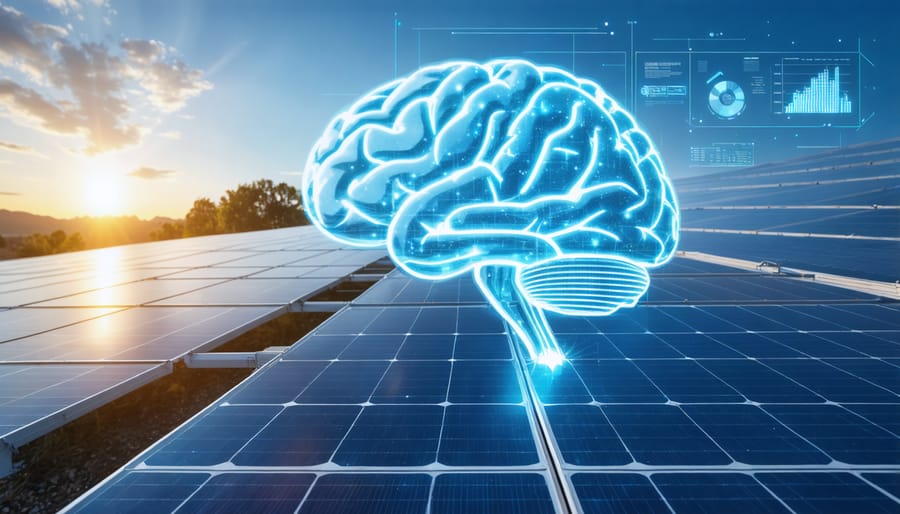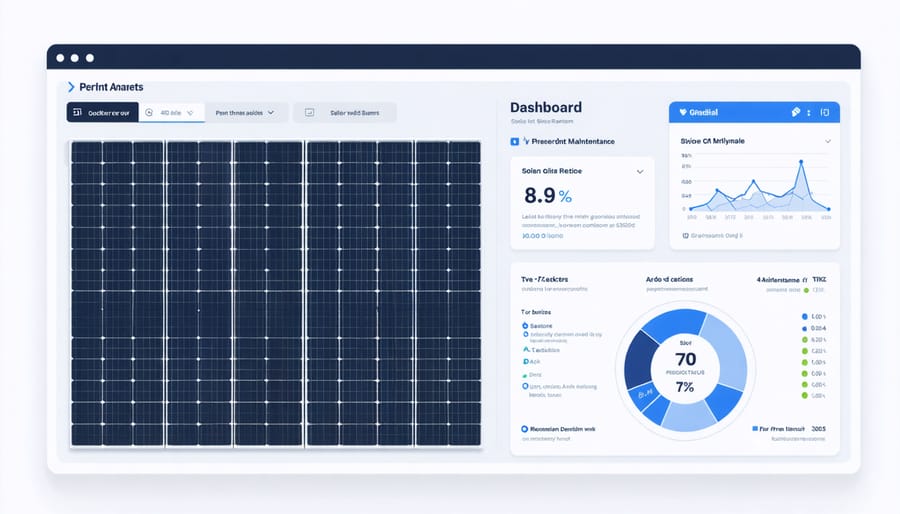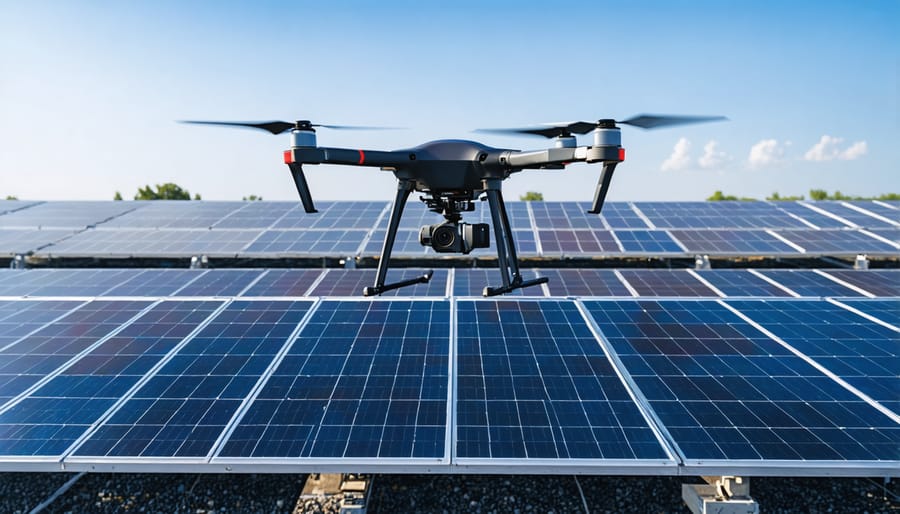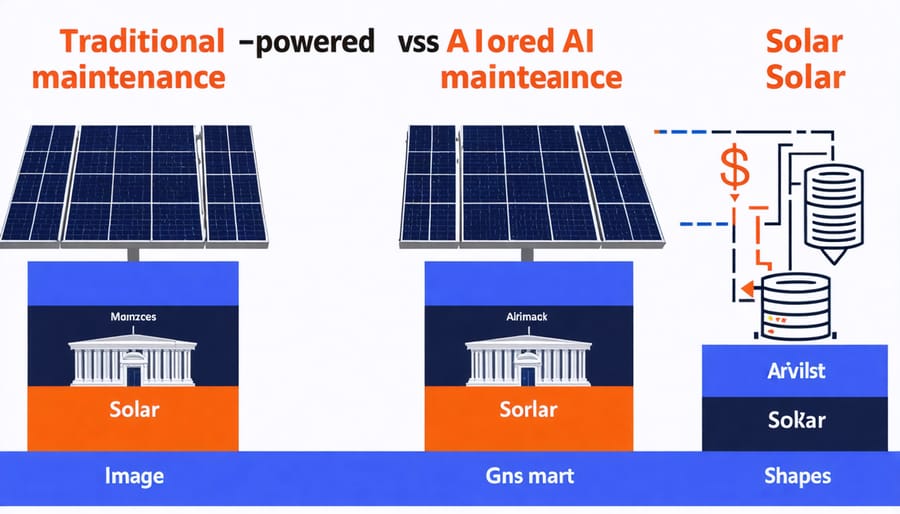AI-Powered Solar Maintenance That Cuts Costs and Boosts Performance

Solar technology stands at the cusp of a revolutionary transformation, driven by breakthrough innovations that redefine how we harness and optimize solar energy. From quantum dot solar cells achieving unprecedented efficiency levels to AI-powered solar maintenance systems that predict and prevent performance issues before they occur, these advancements are reshaping Europe’s renewable energy landscape.
Recent developments in perovskite-silicon tandem cells have pushed conversion efficiencies beyond 29%, while smart solar tracking systems equipped with machine learning algorithms now optimize panel positioning with remarkable precision, increasing energy yield by up to 25%. These innovations arrive at a crucial moment, as European nations accelerate their transition toward sustainable energy solutions.
What makes these technological breakthroughs particularly significant is their practical impact on both residential and industrial applications. Self-cleaning nanotechnology coatings reduce maintenance requirements by 40%, while integrated energy storage solutions featuring advanced battery management systems ensure consistent power delivery even during periods of limited sunlight. For European stakeholders, these innovations represent not just technological progress, but a pathway to enhanced energy independence and sustainability.
How AI is Transforming Solar Panel Maintenance
Predictive Analytics for Early Problem Detection
Modern solar installations are becoming increasingly intelligent thanks to advanced predictive analytics systems. These innovative solutions utilize artificial intelligence to monitor system performance in real-time, analyzing vast amounts of data from multiple sensors and weather forecasts. By detecting subtle patterns and deviations, these smart systems can identify potential issues before they develop into serious problems.
The technology continuously tracks key performance indicators such as voltage levels, temperature variations, and energy output patterns. When abnormal trends are detected, the system alerts maintenance teams, enabling proactive interventions that prevent equipment damage and minimize downtime. For instance, the system might detect gradual degradation in panel efficiency, suggesting the need for cleaning or repairs before performance significantly deteriorates.
European solar facilities implementing these predictive solutions have reported up to 30% reduction in maintenance costs and significant improvements in system reliability. The technology is particularly valuable in large-scale installations, where manual monitoring would be time-consuming and potentially miss subtle indicators of developing problems. This proactive approach ensures optimal system performance while extending the lifespan of solar equipment through timely interventions.

Real-time Performance Optimization
Modern solar installations are increasingly incorporating sophisticated AI-driven monitoring systems that continuously analyze and optimize performance in real-time. These intelligent systems use advanced algorithms to maximize solar panel performance by adjusting parameters such as tilt angles and tracking responses based on weather conditions, sun position, and energy demand patterns.
The AI monitors key performance indicators through a network of sensors, detecting subtle variations in output and environmental factors. When performance drops below expected levels, the system can automatically implement corrective measures or alert maintenance teams. This proactive approach helps prevent energy losses before they become significant issues.
For European installations, these systems are particularly valuable during varying seasonal conditions. The AI adapts to shorter winter days and longer summer periods, ensuring optimal energy harvesting year-round. The technology also learns from historical data, continuously improving its decision-making capabilities to enhance system efficiency.
The result is a more reliable and productive solar installation that requires minimal human intervention while delivering consistent renewable energy output.
Smart Monitoring Systems in Action
Drone-Based Inspection Systems
The integration of drone inspection technologies has revolutionised how we maintain and monitor solar installations across Europe. These autonomous aerial systems, equipped with high-resolution thermal cameras and advanced sensors, can detect potential issues in solar panels with remarkable precision and efficiency.
Modern inspection drones utilise artificial intelligence to analyse vast amounts of collected data, identifying everything from micro-cracks and hotspots to soiling patterns and connection issues. This technology enables maintenance teams to inspect hundreds of panels in a fraction of the time required for manual inspections, while significantly reducing safety risks associated with roof access.
The AI algorithms powering these systems can predict potential failures before they occur, enabling proactive maintenance scheduling and optimising solar farm performance. In countries like Germany and Spain, where large-scale solar installations are common, these systems have demonstrated up to 90% time savings in inspection processes.
For facility managers and solar farm operators, drone-based inspections provide detailed performance reports and maintenance recommendations through user-friendly software platforms. This data-driven approach has proven particularly valuable in northern European regions, where weather-related damage and seasonal variations can significantly impact solar panel efficiency.
The technology continues to evolve, with newer models featuring enhanced autonomous capabilities and more sophisticated analysis tools, making solar maintenance more accessible and cost-effective for installations of all sizes.

IoT Sensors and Data Analysis
Modern solar installations are becoming increasingly intelligent through the integration of sophisticated IoT sensors and data analysis capabilities. These smart sensors continuously monitor various parameters including power output, panel temperature, weather conditions, and system performance metrics in real-time. By collecting this wealth of data, solar installations can operate more efficiently and maintain optimal performance levels.
The sensors work in conjunction with advanced artificial intelligence systems that process and analyse the collected data. This combination enables predictive maintenance, identifying potential issues before they become critical problems. For instance, AI algorithms can detect subtle changes in panel performance that might indicate the need for cleaning or repairs, helping facility managers schedule maintenance activities more effectively.
These smart systems also adapt to local weather patterns and seasonal changes, automatically adjusting panel positioning and operation parameters to maximise energy generation. In European installations, where weather conditions can vary significantly, this capability is particularly valuable.
Data analysis extends beyond basic monitoring to provide comprehensive insights into system efficiency. Facility managers receive detailed reports and recommendations for optimisation, while automated alerts ensure quick response to any anomalies. This intelligence-driven approach has shown to increase overall system efficiency by up to 20% while reducing maintenance costs significantly.
For European businesses and homeowners, these smart solutions represent a crucial step toward more sustainable and efficient solar energy management, offering both environmental and economic benefits through improved system performance and reduced operational costs.

Cost Benefits of AI Maintenance Solutions
Reduced Maintenance Costs
The integration of artificial intelligence in solar technology maintenance has revolutionized cost management for European solar installations. Advanced AI algorithms now continuously monitor system performance, predicting potential issues before they escalate into costly repairs. This predictive maintenance approach typically reduces operational costs by 25-30% compared to traditional maintenance schedules.
Smart monitoring systems analyze real-time data from solar panels, inverters, and other components, automatically adjusting maintenance schedules based on actual wear and environmental conditions. For instance, installations in coastal regions of Europe might require more frequent cleaning due to salt exposure, while inland systems might need less frequent attention. The AI systems optimize these schedules accordingly.
Remote diagnostics capabilities have significantly reduced the need for on-site inspections, cutting travel-related expenses by up to 60%. When technicians do need to visit, they arrive equipped with precise information about the issue, ensuring faster resolution times and minimizing system downtime.
The economic impact is particularly notable in large-scale installations, where AI-driven maintenance has shown to extend equipment lifespan by 15-20%. For residential systems, homeowners typically see maintenance costs decrease by €200-300 annually, while commercial installations report even more substantial savings, often exceeding €1,000 per megawatt installed.
Enhanced System Longevity
Artificial Intelligence is revolutionizing how we maintain and extend the lifespan of solar energy systems across Europe. Advanced AI algorithms continuously monitor system performance, analyzing data from thousands of sensors to detect potential issues before they become critical problems. This predictive maintenance approach has shown to increase system longevity by up to 25% compared to traditional maintenance methods.
The AI systems excel at identifying subtle patterns that might indicate emerging problems, from micro-cracks in solar panels to slight decreases in power output that human operators might miss. By combining weather data, historical performance metrics, and real-time monitoring, these smart systems can optimize cleaning schedules, adjust panel positioning, and recommend precise maintenance timing.
European solar installations equipped with AI-powered monitoring systems have reported significant improvements in operational efficiency. The technology helps prevent unnecessary wear and tear by optimizing system operations based on environmental conditions. For instance, during harsh weather events, AI can automatically adjust panel angles to minimize potential damage while maximizing energy capture.
Moreover, these intelligent systems create detailed maintenance histories and prediction models, enabling facility managers to make data-driven decisions about system upgrades and replacements, ultimately extending the useful life of solar installations while maintaining peak performance levels.
Implementation Strategies for European Businesses
Getting Started with AI Solar Maintenance
Implementing AI-driven solar maintenance systems begins with integrating smart sensors across your solar installation. These sensors continuously monitor key performance indicators such as power output, temperature, and equipment health. Start by conducting a thorough assessment of your current essential maintenance practices to identify areas where AI can add value.
The next step involves selecting an AI platform compatible with your installation’s size and requirements. Most European solar providers now offer integrated solutions that combine hardware sensors with sophisticated software systems. Begin with a pilot programme on a small section of your installation to test the system’s effectiveness.
Configure the AI system to establish baseline performance metrics and set alert thresholds. The system will learn from your installation’s specific conditions, gradually improving its predictive capabilities. Ensure your maintenance team receives proper training on the new system’s interface and alert protocols.
Regular system updates and data analysis reviews are crucial for optimising the AI’s performance. Start with basic monitoring and gradually expand to more advanced features as your team becomes comfortable with the technology.
Choosing the Right AI Solution
When selecting an AI solution for your solar installation, consider first the size and complexity of your system. Small residential installations might benefit from basic monitoring AI that tracks performance and predicts maintenance needs, while larger commercial systems often require more sophisticated solutions with advanced analytics capabilities.
Key factors to evaluate include the AI system’s compatibility with your existing solar hardware, data processing capabilities, and the level of automation required. European solar operators should ensure the chosen solution complies with GDPR and relevant EU energy regulations.
Look for AI platforms that offer real-time monitoring, predictive maintenance features, and clear reporting interfaces. The solution should provide actionable insights rather than just raw data, enabling proactive maintenance decisions that optimize system performance.
Consider also the vendor’s track record in the European market, their technical support infrastructure, and the scalability of their solution. The best AI systems grow with your installation and adapt to changing environmental conditions and energy demands.
Evaluate the total cost of ownership, including implementation, training, and ongoing support. While premium solutions may have higher upfront costs, they often deliver better long-term value through improved efficiency and reduced maintenance expenses.
Future of AI in Solar Maintenance
Artificial Intelligence is revolutionising solar maintenance across Europe, ushering in a new era of predictive and automated care for solar installations. Advanced AI algorithms now process vast amounts of performance data, enabling systems to detect potential issues before they become critical problems. This shift from reactive to predictive maintenance is significantly reducing downtime and optimising energy production for both residential and commercial installations.
Machine learning systems are becoming increasingly sophisticated in analysing weather patterns, energy output fluctuations, and component degradation rates. These systems can now predict when panels need cleaning, identify potential hardware failures, and even optimise panel angles in real-time for maximum energy capture. In many European installations, AI-powered drones are already conducting automated inspections, using thermal imaging and high-resolution cameras to detect hotspots, microcracks, and other defects that might be invisible to the human eye.
Looking ahead, we can expect to see AI maintenance systems becoming more autonomous and interconnected. The integration of IoT sensors with AI platforms will enable truly smart solar farms that can self-diagnose and, in some cases, self-repair through automated systems. European research institutions are developing AI models that can adapt to local environmental conditions, ensuring optimal performance across different climate zones.
The economic impact of AI in solar maintenance is substantial, with early adopters reporting maintenance cost reductions of up to 30% and efficiency improvements of 15-20%. As these technologies become more accessible, we’re likely to see widespread adoption across both large-scale solar farms and residential installations, making solar energy an even more attractive and reliable investment for European property owners.
As we’ve explored throughout this article, innovative solar technologies are revolutionizing how European businesses and homeowners harness solar energy. These advancements, from AI-driven maintenance systems to smart monitoring solutions, are making solar power more efficient, reliable, and cost-effective than ever before.
The benefits of embracing these innovations are clear: reduced maintenance costs, improved system performance, and enhanced energy yields. For European organizations, this translates into stronger sustainability credentials, better return on investment, and increased energy independence. The integration of smart technologies with solar systems also positions businesses to meet increasingly stringent environmental regulations while contributing to the EU’s renewable energy goals.
The time to act is now. With generous incentives available across many European countries and rapidly evolving technology making solar more accessible, there’s never been a better moment to invest in advanced solar solutions. Whether you’re considering your first solar installation or looking to upgrade existing systems, these innovations offer practical pathways to optimize your energy infrastructure.
By embracing these technological advances, you’re not just investing in your property or business – you’re participating in Europe’s clean energy transition. We encourage you to explore these solutions with qualified solar professionals who can help tailor these innovations to your specific needs and circumstances. The future of solar is bright, and these technologies are lighting the way forward.
Leave a Reply